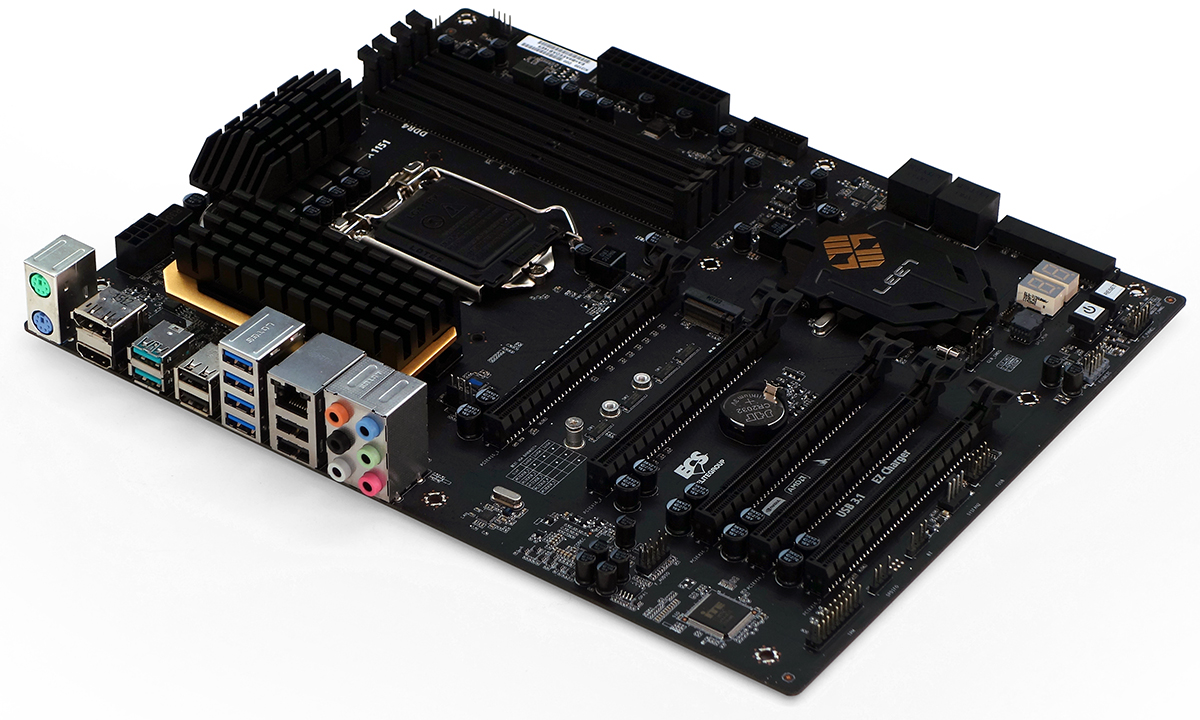Early Verdict
The Z170-Claymore has all the hardware needed to compete for an enthusiast-market value title, but the firmware still needs work. We’d wait for a few early-adopters to report their findings on new firmware before buying.
Pros
- +
Four double-slot graphics cards in x8-x4-x8-x4 mode • Price
Cons
- -
Shared slot and M.2 connector lanes • Multi-graphics performance • Chipset bandwidth limitations • No SLI • Immature BIOS • Hindered DRAM overclocking • Overly aggressive overcurrent protection • High default voltage at maximum CPU load
Why you can trust Tom's Hardware
Introduction
Rumors that ECS would leave the branded motherboard business turned out to be unfounded, as the firm instead dropped the word “Gank” out of the branding of its latest motherboards. The L337 Gaming website is similarly fading into the background as the company focuses more of its effort on the ECS brand, and the hardware that represents it. Even though the old logo remains in spirit, L337 has transformed to LEE7.
The Z170-Claymore leads ECS’s LGA 1151 effort with all the parts and interfaces a mid-market enthusiast would want, such as dual USB 3.1 ports, a status code display for debugging, overclocking support in firmware, PCIe 3.0 M.2, and the ability to support multiple graphics cards. These specs look particularly good with regard to its mid-market $160 price.
ECS isn’t buying the hype over USB 3.1 Type-C connectors, instead outfitting the Claymore with two USB 3.1 Type A ports. This allows the ports to support many more types of devices, since most users will likely never replace their Type A to B or Micro USB cables with Type-C versions. Meanwhile, Type A to Type-C cables are likely to become commonplace as people use these to charge their phones.
Other rear-panel USB ports include four USB 3.0 and four USB 2.0, the latter making sense for at least two ports since all USB keyboards and mice use either USB 2.0 or 1.1 modes. Other keyboard and mouse options include two PS/2 ports, where most of ECS’ competitors believe that one is more than sufficient.
The Claymore’s I/O panel still has leftover space, causing us to question what might be missing. One thing thankfully gone is the VGA port of yore, though breaking out to one is still possible through DisplayPort. DVI is also missing, though breaking out to that is easy via HDMI. Gigabit Ethernet is limited to a single port, but we didn’t expect two at this price level. The real shocker is probably that the Z170-Claymore doesn’t have any optical S/PDIF output, not even via a combined jack, and instead relies on an internal header and a separately-purchased third-party breakout plate to fulfill the needs of those specific users. On the other hand, the lack of DTS Connect or DDL often makes 5.1 or 7.1 analog connections a preferred solution for positional audio in games.
Get Tom's Hardware's best news and in-depth reviews, straight to your inbox.
-
utroz Seriously where is the Display Port. HDMI is for TV"s not real monitors. I can use a passive adapter from DP to HDMI if I want to use a crappy TV as a monitor..Reply -
SinxarKnights Sorry ECS. I have used your boards in the past and they all died a horrible death for no apparent reason.Reply
Since I first spotted these MBs on Newegg, calling them LEET seems like they are spitting in my face. I actually thought it was a scam until I later learned they are ECS boards.
I don't know about others but when I look for a quality motherboard it better not have l337 in the title, it just reeks of some garbage you would try to market to very young children... or maybe that is the goal? -
bignastyid Atleast they named it right. Who is going to be surprised when something named Claymore blows up.Reply -
Crashman Reply
Every problem I've had with ECS has been firmware-related. I really don't expect it to "blow up".16572439 said:Atleast they named it right. Who is going to be surprised when something named Claymore blows up.
-
bignastyid Reply16572532 said:
Every problem I've had with ECS has been firmware-related. I really don't expect it to "blow up".16572439 said:Atleast they named it right. Who is going to be surprised when something named Claymore blows up.
It was more a figurative term, sounded better than die young. Which is what I have seen them do most often(a couple did have exploded capacitors), but this was years ago don't see them as often any more(thank god). Now of they made power supplies like their motherboards they probably would literally blow up. -
Crashman Reply
ECS has been doing OK on the hardware side since its first gaming brand launch 2005, but every time they get close to having a decent firmware they change it up and start over again.16572559 said:16572532 said:
Every problem I've had with ECS has been firmware-related. I really don't expect it to "blow up".16572439 said:Atleast they named it right. Who is going to be surprised when something named Claymore blows up.
It was more a figurative term, sounded better than die young. Which is what I have seen them do most often(a couple did have exploded capacitors), but this was years ago don't see them as often any more(thank god). Now of they made power supplies like their motherboards they probably would literally blow up.
-
Mac266 ReplyAtleast they named it right. Who is going to be surprised when something named Claymore blows up.
A Claymore is a large two-handed sword. -
Crashman Reply
OK, now using it that way would probably break it.16580242 said:Atleast they named it right. Who is going to be surprised when something named Claymore blows up.
A Claymore is a large two-handed sword.

